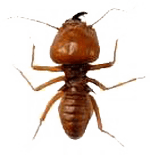Subterranean Termites Kansas City
Subterranean Termites Kansas City Subterranean Termites Kansas City
Subterranean Termites Kansas City
Scientific Name: Reticulitermes flavipes
Class/Order/Family: Insecta/Isoptera/Rhinotermitidae
We know that the earliest known fossils of termites date back to about 130 million years ago. There are more than 2600 species of termites worldwide. Subterranean Termites Kansas City, believe it or not, are related to cockroaches and mantids. They develop with incomplete metamorphosis and include the caste system of a nymph, worker, pseudergate, soldier, and many reproductive’s. The nymphs hatch from eggs and molt at least three times before they become developed functioning workers. The workers have no eyes and are blind.
We mainly deal with only one termite here in Missouri and Kansas in the Greater KC area, and that is of the Eastern Subterranean Termite Kansas City. Three families of termites in the Order, Isoptera (even wings), are found in North America and have subterranean habits. The Rhinotermitidae is the one we come in contact with the most here in Kansas and Missouri. In the United States, subterranean termite occurs in every state except Alaska. The one species of Rhinotermitidae that we deal with more here in the Greater KC area is the species of Reticulitermes, and the main genus that occurs is that of flavipes.
Damage: Subterranean termites eat wood and are very destructive to your home or building. Several billions of dollars are spent every year repairing damage and performing treatments to houses because of this destructive insect.
Professional Control: After a thorough inspection by a Certified ZipZap Bed Bug KC termite inspector, he/she will present you with options as to what is the best prescription treatment, designated by our Board Certified Entomologist, for your home or commercial space. The extent of the infestation must be assessed by searching and probing of wood and determining the level of damage in your home or building. Shoddy building practices, especially where wood is in contact with soil, and cracks in concrete foundations, lead to many termite infestations.
Preventative Control: What you can do as a homeowner or property manager to keep termites from finding your structure irresistible.
1. Eliminate all soil contact with structural timbers, form boards, and other wood around the home or building.
2. Remove all wood debris, stumps, scrap wood, cardboard boxes and newspapers under and around the building.
3. Correct all moisture problems associated with the structure.
4. Eliminate all dense vegetation around the structure,
5. Adjust the grade of the soil around the home or structure, so surface water drains away from the structure.
Avoid using wood chips and mulch around your foundation.

